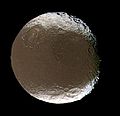Lêer:Iapetus Spins and Tilts.jpg
Iapetus_Spins_and_Tilts.jpg (361 × 349 piksels, lêergrootte: 13 KG, MIME-tipe: image/jpeg)
Lêergeskiedenis
Klik op die datum/tyd om te sien hoe die lêer destyds gelyk het.
| Datum/Tyd | Duimnael | Dimensies | Gebruiker | Opmerking | |
|---|---|---|---|---|---|
| huidig | 02:36, 5 Desember 2015 |  | 361 × 349 (13 KG) | PlanetUser | Cropped 42 % horizontally and 42 % vertically using CropTool with precise mode. |
| 20:04, 10 Oktober 2006 |  | 618 × 605 (18 KG) | Uwe W. | '''Original Caption Released with Image:''' Saturn's two-faced moon tilts and rotates for Cassini in this mesmerizing movie sequence of images acquired during the spacecraft's close encounter with Iapetus on Nov. 12, 2005. The encounter begins with Cas |
Lêergebruik
Die volgende bladsy gebruik dié lêer:
Globale lêergebruik
Die volgende ander wiki's gebruik hierdie lêer:
- Gebruik in an.wikipedia.org
- Gebruik in de.wikipedia.org
- Gebruik in en.wikipedia.org
- Gebruik in en.wikiversity.org
- Gebruik in fr.wikipedia.org
- Gebruik in ja.wikipedia.org
- Gebruik in ko.wikipedia.org
- Gebruik in lt.wikipedia.org
- Gebruik in lv.wikipedia.org
- Gebruik in nn.wikipedia.org
- Gebruik in no.wikipedia.org
- Gebruik in pt.wikipedia.org
- Gebruik in ro.wikipedia.org
- Gebruik in ru.wikipedia.org
- Gebruik in sco.wikipedia.org
- Gebruik in sk.wikipedia.org
- Gebruik in tr.wikipedia.org
- Gebruik in uk.wikipedia.org
- Gebruik in vi.wikipedia.org


